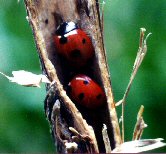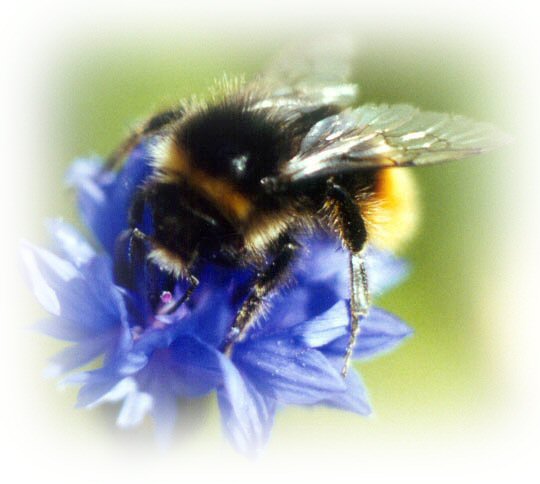| Home | Wildflowers and Meadows | The Wildlife Garden | The Cottage Garden | Protection of Wildflowers | Plants, Wildflowers and Herbs Available | Trees and Hedging | Seeds | Shop | Contact | Links | Trade and Wholesale |
Ladybirds, Lacewings and Hoverflies
 |
Aside from butterflies, moths and bees, you also want to attract ladybirds and lacewings, major devourers of pests such as aphids. To attract these you can buy lacewing nesting boxes, or keep the garden untidy with bits of twigs and leaf debris for ladybirds to nest in. Hoverflies are also essential in the wildlife garden - their larvae eat aphids too and prefer yellow and gold plants, such as Marigolds. |
Ladybirds
Ladybirds are pretty little beetles that everyone recognises, there being some 26 species in the UK. The 7-spot is the most common in the UK, having 7 black spots on its body. It is thought that the ladybird species derived its name from the 7-spot - "lady" referring to the Virgin Mary who, in early paintings, is seen wearing a red cloak. The 7 spots are symbolic of the 7 joys and sorrows of Mary. Ladybirds hibernate in winter, often in large groups, under tree bark, in leaves or stems, for example. They emerge from hibernation in late March/April and lay their bright yellow eggs on the underside of leaves. In about a week the black larvae hatch and look almost alien with their long, scaly bodies and 6 legs. They shed their skins 3 times and eat voraciously of aphids and other scale insects before becoming pupae. They spend a week as pupae, undergoing a major transformation, and then emerging as ladybirds. A ladybird lives for around a year, consuming around 5000 aphids during that time.Attract ladybirds to your garden by providing them with ideal nest sites - either buy purpose-built ladybird boxes or simply deadhead old plants, leaving the stems, preferably hollow, for the ladybirds to hibernate in over winter. If you have Fennel, cut down the hollow stems and stack them in a sheltered spot.
Hoverflies
Hoverflies are recognisable by their yellow and black stripes and their habit of hovering over flowers. They are easy to identify from wasps or bees aas they only have one pair of wings (bees and wasps have two pairs). Hoverflies are good predators and pollinators. There are many different types of hoverfly and you would need to be a bit of an expert to identify them all! Hoverflies are sometimes known as Marmalade flies. Females lay their eggs near supplies of aphids and the larvae hatch a few days later. During their 3-week development they will eat loads of aphids. Hoverfly larvae are like maggots, white and almost transparent. Hoverflies particularly like umbellifers such as Cow Parsley and Hogweed.
Lacewings
There are three types of Lacewing - green, white and pwdery. Their larvae look very similar to ladybird larvae. The green lacewing is the largest of the 3, with a wing span of 20 - 48 mm. The brown is next with a wing span of 15 - 20 mm. The smallest is the powdery with a wing span of only 7 - 8 mm - this insect has a p[owdery white coating over its body. A female lacewing lays around 300 eggs and each larvae eats 1000 - 10000 aphids in its lifetime. Lacewing eggs are laid on a thread of hardened mucous. You can buy lacewing boxes to tempt them in over winter.
:
Like this page? Then tell a friend! Click here to tell your friends about The English Cottage Garden Nursery.
| Butterflies and Moths | Bees | Birds | Bats | Small Mammals | Ladybirds, Lacewings, Hoverflies |
 The English Cottage Garden Nursery
The English Cottage Garden Nursery